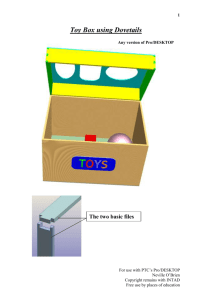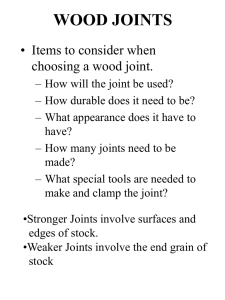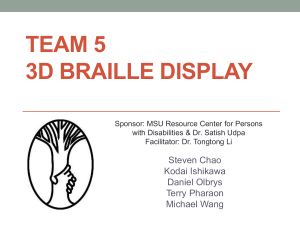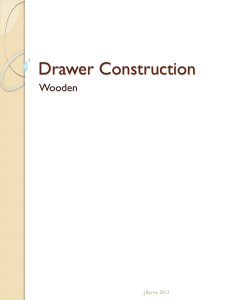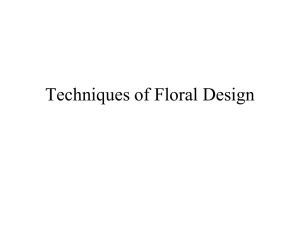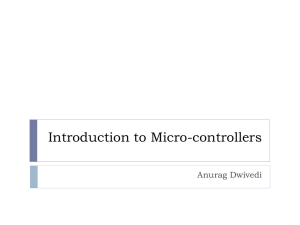Types of Dovetails - Jerill Vance Woodworks, LLC
advertisement
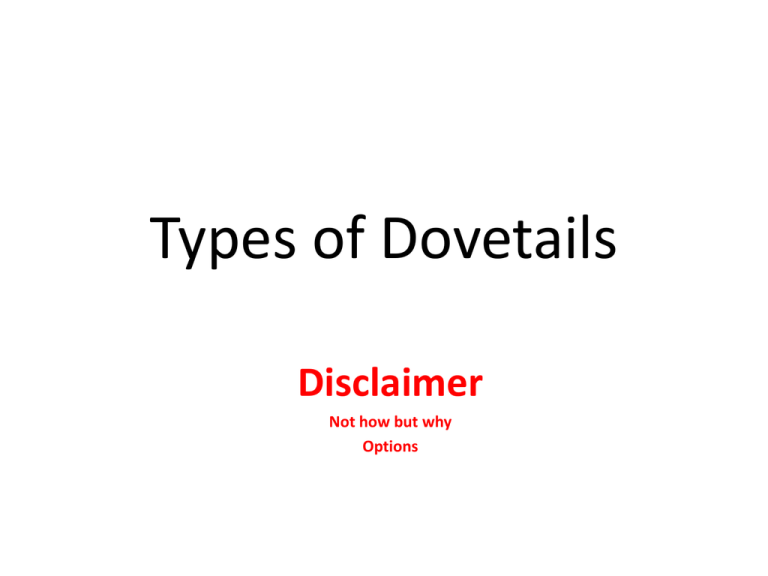
Types of Dovetails Disclaimer Not how but why Options Dovetail Discussion • Partially housed, tapered mortise and tenon joint • Cousin of box joint (see drawing) • Old joint • Strong joint • Mechanical joint • Increases glue surfaces • Directional joint • Exposed vs. non-exposed • Start and end with pin or tail (?) • Symmetrical vs. Asymmetrical – Strength – Proportions (size) – Decorative • • • • • • • Self aligning and squaring Sign of craftsmanship Learning curve Time involved Easy to fix mistakes Single use or variety of use Eliminates the use of mechanical fasteners (except dowels) • Angles of dovetails • Not just furniture/cabinetmaking – Timber framing – Metal work – Masonry – Machinery Angle of dovetail • Generally expressed as ratio (rise/run)– not in degrees • 1:6 for softwood (9.5 degrees) • 1:8 for hardwood (7.1 degrees) • 1:4 for thin stock (14 degrees) • Hardwood/softwood mixed? • Old furniture vs. new dovetails • Router bits for machine cut dovetails – 7 to 14 degrees common • Marking gauges for dovetails (manufactured and shop made) • Personal preference – looks Excessive Angles for Dovetails Results of Excessive Angles •Common dovetail bits by two manufacturers. •Angle vs. depth of cut •Notice the range in the angles. •Must allow room for shank of router bit. Dovetail Bevel • To find the angle draw a line square with the edge of a board and divide it into 6 or 8 parts as desired; from the end of the line and square with it, mark off a space equal to one of the divisions and set the bevel as shown. Dovetail Marker •Manufactured dovetails markers mostly cover 3 common sizes. •Shop made dovetails markers can be customized. Full/Through Dovetails Identify Tails or Pins by looking at the face of the board. Hand cut vs. machine cut vs. template cut Directional – be aware of forces Exposed vs. non-exposed Thickness of wood Species of wood (fibers) Symmetrical vs. Asymmetrical Number of tails – even vs. odd Proportions of tails and pins Size of pins Half pin vs. half tail at top Proud vs. flush Undercut vs. square cut Long grain vs. end grain glue surface Full/Through Dovetail From Audell ‘s Shop Manual 1923. Dovetails are a dying art? 1902 Half Pin vs. Half Tail Dovetail •Strength •Location of groove for insert •Personal preference Beveled Dovetails • A full/through dovetail where one of the boards are at an angle other than a right angle. • Common on tool totes. • Use a “wedge” with marker to layout dovetails. Compound Dovetail •A full/through dovetail where both of the boards are at an angle other than a right angle. •Common on serving trays. Lap Dovetail • Lap joint in the shape of a dovetail. • Can be full lap or half lap dovetail • Can be blind or through • Commonly used where the top drawer rail meets the leg • Limitations? Sliding Lap Dovetail • • • • Directional Cross grain Half or full lap Can be used to allow for movement Bridle Dovetail •Like a bridle joint except the insert is dovetail shaped instead of rectangular. •Mortise and tenon vs. bridle joint. •Directional - only on exposed ends of boards. Dovetail Scarf Joint Used in place of a butt joint. Half Blind Dovetail • Joint hidden from front • Tails on side fit into sockets on front • Directionally strong • Time • Be aware of direction • Commonly used in drawers and cases Full Blind/Double Lap/Secret Dovetail Joint hidden from front and side Also called hidden or secret dovetail joint Molding of furniture Veneer work? Time Hides joinery and craftsmanship Blind Mitered Dovetail • Top pin is mitered • Same as full blind except lap is mitered • Time • Hides dovetails • Strong exposed miter joinery • Eliminates cupping • Furniture Mitered Through Dovetail • Top pin or tail is mitered • Rest of dovetails are through • Common on tool chests, serving trays • Anywhere the top rail is prominent Anatomy of a Mitered Through Dovetail Sliding/Housed/Tapered Dovetail Dovetailed shaped dado Cross grain - be aware of expansion of wood Slides through – directional Can be parallel or tapered Stopped or through Hand cut vs. template cut Shelves and dividers Half Sliding/Bareface Dovetail • One side is square and the other is dovetailed • Can be tapered • Stopped or through • Used when board is too thin for dovetails on both faces - strength • Commonly used in pigeon holes of desks and secretary Diminished Dovetail Cross between dado and sliding dovetail Always a stop joint Directional Tensioned Dovetail • Dovetails are narrow at edges and progress to wider in middle • Makes joint stronger at edges • Saves time • Looks interesting • Large chests Modified Tensioned Dovetail • More artistic than functional • Stronger at ends but balanced proportio ns Decorative Dovetail (Hounds tooth) • Many unique dovetails fit this category • Sometimes cut in an arc shape • Pins and tails can be shaped differently • Opportunity to set your own style Hounds Tooth Dovetail in progress • Note small sized pins • Pins set inside dovetail • Off set at top of pin board Doweled Dovetail • Dovetails for strength • Dowels are quicker and added for strength • Interesting look Double Dovetail • Made famous by Incra • Through or half blind • Usually contrasting species of wood to highlight joinery • Can be cut by hand – usually with contrasting wedges installed in kerfs at joints • Decorative boxes Hand Cut Double Dovetail • Hand cut • Contrasting wood to accentuate the double dovetail • Interesting look • Twice the time Dovetail Keys and Splines •Align cross grain •Prevent warping and bowing •Allow cross grain movement •Reinforce joint •Decorative •Quick and easy •Boxes Dovetail Inlay - Dutchman •Inlay dovetail (bowtie) shaped piece of wood to hold split from opening up more •Usually contrasting piece of wood •Accentuates a flaw •Decorative Other Dovetails?? • Comments on other unusual dovetails? You should be aware of the many different kinds of dovetails and their uses. This needs to include the strengths and weaknesses of each joint, so the next time you can determine the correct dovetail for your specific application. With knowledge, skill and experience you can alter or design your own style of dovetail joints! Questions or Comments? Suggestions?
